 Written by Hulet Smith, OT
Written by Hulet Smith, OT
Gone are the days when physical therapy was performed on the floor. The advent of the mat table delivers the space for practitioners to perform manipulations, reduces bending and straining for those providing treatment, and eliminates the risk of injury posed by getting patients down to and up from the floor. Some of the best exercises you can do are stretches that improve your range of motion. With enough space and easy access for important bodywork like stretching, range-of-motion exercises, deep tissue massage, myofascial release, and joint manipulation, a mat table is a valuable addition to any professional or home therapeutic environment.
A mat table is a large, sturdy rehabilitation table used by physical therapists. These tables are usually made of wood and topped with a thick foam mat covered in fabric or vinyl for patient comfort and support. Also called mat platforms, and physical therapy tables, mat tables are lower than traditional treatment tables to allow for patients to transfer easily from a wheelchair, and provide complete therapist access. Most standard mat tables have a weight capacity of around 600 pounds. With bariatric models serving patients weighing up to 1,000 pounds.
The two types of mat tables are static (stationary) and power-adjustable. Here is what you need to know about these types of tables and our top-selling products!
Static treatment mats offer a wide, safe, and sturdy surface on which therapists can perform exercises to increase mobility, strengthen limbs, and soothe stiff and sore muscles. These tables do not have a lot of padding, as they are focused less on comfort and more on therapeutic results. The solid surface they provide allows the therapist to effectively perform body manipulations and have the patient perform accurate movements.
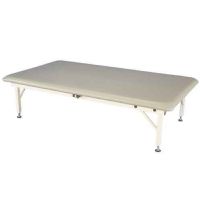 | Armedica Bariatric Electric Hi-Lo Mat Treatment Table View Product |
Power adjustable mat tables, also called treatment mat platforms, offer solid stability, legroom, and maneuverability for the clinician, with high-low electric height adjustment. This adjustability is especially useful for bariatric patients, as the table can be adjusted to a height that is comfortable and safe for a patient to get on and off the table. It also can be set to the best height for practitioners so they don’t have to strain to get into a position to deliver therapy. This adjustability ensures maximum results with minimal effort.
Besides the two types of mat tables, there are mat tables designed to accommodate patient conditions. Below, we list a few mats that were created with the patient in mind, and our best-recommended products.
 | Armedica Bariatric Electric Hi-Lo Mat Treatment Table View Product |
A bariatric mat table can accommodate patients over 600 pounds. Some bariatric tables have a weight capacity as high as 1000 pounds. The heavy-duty design of these bariatric tables ensures every patient can be treated with the therapy they need to achieve the highest level of health and wellbeing.
.png&newwidth=365&maxheight=200) | Armedica Manual Adjustable Mat Table with Backrest View Product |
Not every patient is comfortable or able to take treatment lying flat. For certain conditions, it’s better for the patient to be able to sit up during physical therapy. A two-section mat table with an adjustable backrest increases patient comfort and facilitates a versatile treatment approach.
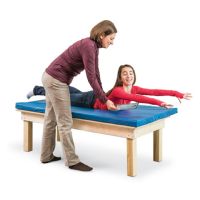 | Mat Table with Padded Top by Southpaw Enterprises View Product |
Built specifically for children, pediatric table mats are smaller to ensure the therapist can get in close hands-on proximity to younger, smaller patients. In addition to regular physical therapy, these tables are appropriate for occupational therapists working on motor skills, balance, eye movement, and spatial orientation.
.jpg&newwidth=365&maxheight=200) | Hausmann Dual Lift Powermatic Mat Platforms View Product |
For patients approaching a treatment table from a wheelchair, a transfer to a table that is too high or too low can be uncomfortable or even dangerous. Adjustable mat platforms that can meet wheelchair seat height make it much easier for a patient to self-reposition or be assisted to a same-level surface for treatment.
Some mat tables are created for specific environments, or have ergonomic features. Check these out!
_(1).jpg&newwidth=365&maxheight=200) | Bailey Wall Mounted Mat Table View Product |
For schools or other treatment rooms with no room to spare, a wall-mounted mat table that tucks away next to the wall when not in use is a great option. Pull it out for treatment, and fold it up and out of the way when you need the floor space for other activities.
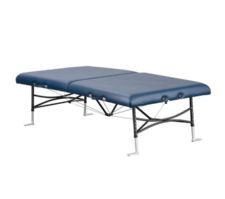 | Oakworks Storable Portable Mat Table View Product |
Portability means a therapist can take treatment on the road, serving patients in their homes or in other rooms in a school or hospital. This option is very popular with therapists who have patients who can’t comfortably or safely get to the therapy suite to get the benefits of physical or occupational therapy.
Surface contamination is an issue in healthcare settings. Since people in need of therapy often are facing compromised health, it is imperative that any treatment setting be as hygienic as possible. Mat tables that have antimicrobial upholstery have been developed to provide an extra layer of protection for anyone exposed to a table surface. This helps create an overall healthy treatment environment.
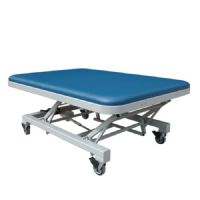 | Tri W-G Deluxe Hi-Lo Mat Platform View Product |
When therapy is delivered in different rooms or spaces, either because of space or patient location, the ability to roll a stable mat table is invaluable in delivering therapy where it’s most beneficial. A strong height adjustable table with locking casters for security and stability is the perfect addition to a practice where therapy isn’t necessarily performed in a static location.
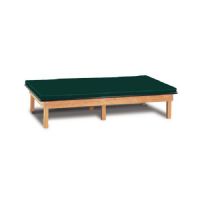 | Metron Value Mat Platform Table with Removable Mat View Product |
Although it’s preferable to not be limited to conducting therapy on the floor, there are times when it’s the best choice for a patient. Having a table with a removable mat that can be used on a table or on the floor is like having two pieces of equipment for the price of one, allowing a therapist to choose which works best in a situation, without having to compromise because of a lack of available options.
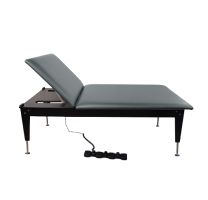 | Hausmann Electric Hi-Lo Mat Platform with Powerback View Product |
Some patients require more hands-on care and assistance than others. With hands-free foot controls, practitioners can focus their attention solely on the position and condition of the patient. This creates a safer environment for the patient and better management of care for the therapist.
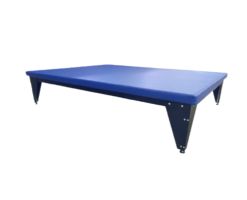 | Bailey BariMatic Electric Hi-Low Upholstered Bariatric Mat Table View Product |
The benefits of steel-framed mat tables include high lifting capacity. These tables are powder coated for durability and can stand up to heavy-duty use serving the heaviest of patients. They are sturdy and will last for years.
Typical mat dimensions include 4’x7’, 5’x7’, and 6’x8’. These measurements make mat tables larger than regular treatment tables, because they are designed to have enough space to roll the patient over or get on the table to apply pressure or leverage during therapy. For pediatric patients, the smallest size ensures the best fit, and bariatric patients do best with the larger sizes.
Standard mat tables accommodate about 66 pounds (which can include a therapist and a patient on the table at the same time). Bariatric treatment tables have weight limits as high as 1,000 pounds. When choosing the correct mat table, consider whether you will be working with bariatric patients, and if this is a table feature you might need.
Foam padding thickness and firmness are a matter of preference and budget. Thicker padding will cost more, but will prevent patients from coming into contact with the hard table surface during therapy. If you are doing a lot of therapy, you will wear out a thinner pad and perhaps need to replace one sooner than if you’d purchased a thicker pad.
A removable mat makes cleaning easier and provides the opportunity to move the mat from the table frame to the floor, creating additional therapy options that might not be available if the mat was in a fixed position.
A fixed mat stays put and you don’t have to worry about it slipping during cleaning, moving, or delivering therapy.
If you’ve invested in your brand, you want the pieces of equipment you use to look good and complement each other and the workspace. When you are putting together your wish list for practice equipment, choosing an upholstery color that fits in well with your practice will project professionalism. Having a standard color scheme also makes ordering replacement and additional equipment easier, knowing the treatment area will have a cohesive and intentional look and feel.
Wood tables have limited stain selection, so you can’t color-match your table legs to your decor and there are fewer color customization options. Wood tables will also show wear with nicks and dings. Steel and aluminum tables usually have longer warranties, and their powder-coated finish can be touched up with a paintbrush to stay looking great longer. They are also more antimicrobial (mold) than wood, and are more durable in wet conditions. Metal tables cost more than wood tables, and are more likely to have electric height adjustability.
Mat tables typically come with four or six legs. Shorter wooden stationary tables will often have six legs for stability, but taller versions distribute weight differently so might have only four legs. For heavy-duty use and/or use with bariatric patients, tables with six legs will provide more stability for therapy.
A: The most common sizes are 4’x7’, 5’x7’, and 6’x8’.
A: A mat table provides easy client access and enough space to perform bodywork, often with the therapist on the table. Therapists can treat clients with floor exercises without having to be on the floor.
A: A physical therapy table is another name for a mat table
For a variety of reasons, physical therapy floor exercises are better performed on an elevated table. Whether it’s due to a patient’s mobility issues or a therapist’s most comfortable position to deliver treatment, a mat table opens up the benefits of floor exercises even when not on the floor. Mat tables provide space and easy access for bodywork and add to the therapeutic experience for the patient while reducing strain on the therapist.
From portable for mobile use to wall-mounted to save space, to bariatric mat tables that accommodate 1,000-pound loads, there are a wide range of table sizes and features to choose from. Features such as thick padding for comfort, anti-microbial upholstery to stop the spread of germs, and long-wearing finishes can all play a part in helping you decide which features - and which mat table - will be the best fit for you.
For more products, browse our selection of Mat Tables, Power Mat Tables, and Static Mat Tables.
Thank you for reviewing our tips on how to choose the mat table that will best meet your needs. We invite you to visit Caregiver University for more information, buying guides, and helpful articles.

Co-founder/CEO of Rehabmart, Pediatric Occupational Therapist, husband, and father. Passionate about connecting special needs kids with superb nutrition, sensory integration, and complementary health strategies. Excited about Rehabmart's mission to become the premier online educational platform which empowers caregivers by spotlighting innovative devices and interventions to achieve optimal patient response and recovery.